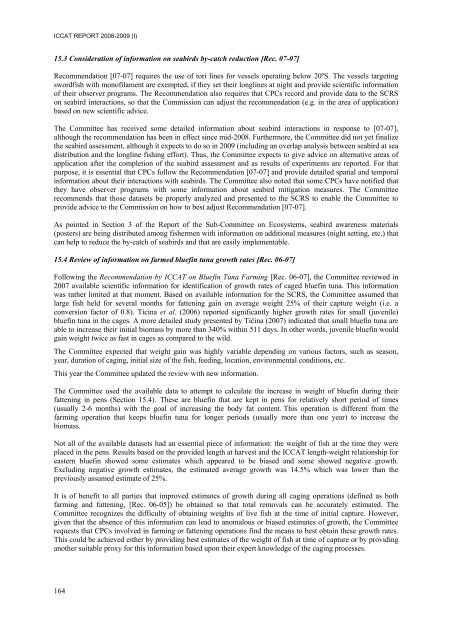REPORT OF THE STANDING COMMITTEE ON RESEARCH ... - Iccat
REPORT OF THE STANDING COMMITTEE ON RESEARCH ... - Iccat
REPORT OF THE STANDING COMMITTEE ON RESEARCH ... - Iccat
Create successful ePaper yourself
Turn your PDF publications into a flip-book with our unique Google optimized e-Paper software.
ICCAT <strong>REPORT</strong> 2008-2009 (I)15.3 Consideration of information on seabirds by-catch reduction [Rec. 07-07]Recommendation [07-07] requires the use of tori lines for vessels operating below 20ºS. The vessels targetingswordfish with monofilament are exempted, if they set their longlines at night and provide scientific informationof their observer programs. The Recommendation also requires that CPCs record and provide data to the SCRSon seabird interactions, so that the Commission can adjust the recommendation (e.g. in the area of application)based on new scientific advice.The Committee has received some detailed information about seabird interactions in response to [07-07],although the recommendation has been in effect since mid-2008. Furthermore, the Committee did not yet finalizethe seabird assessment, although it expects to do so in 2009 (including an overlap analysis between seabird at seadistribution and the longline fishing effort). Thus, the Committee expects to give advice on alternative areas ofapplication after the completion of the seabird assessment and as results of experiments are reported. For thatpurpose, it is essential that CPCs follow the Recommendation [07-07] and provide detailed spatial and temporalinformation about their interactions with seabirds. The Committee also noted that some CPCs have notified thatthey have observer programs with some information about seabird mitigation measures. The Committeerecommends that those datasets be properly analyzed and presented to the SCRS to enable the Committee toprovide advice to the Commission on how to best adjust Recommendation [07-07].As pointed in Section 3 of the Report of the Sub-Committee on Ecosystems, seabird awareness materials(posters) are being distributed among fishermen with information on additional measures (night setting, etc.) thatcan help to reduce the by-catch of seabirds and that are easily implementable.15.4 Review of information on farmed bluefin tuna growth rates [Rec. 06-07]Following the Recommendation by ICCAT on Bluefin Tuna Farming [Rec. 06-07], the Committee reviewed in2007 available scientific information for identification of growth rates of caged bluefin tuna. This informationwas rather limited at that moment. Based on available information for the SCRS, the Committee assumed thatlarge fish held for several months for fattening gain on average weight 25% of their capture weight (i.e. aconversion factor of 0.8). Ticina et al. (2006) reported significantly higher growth rates for small (juvenile)bluefin tuna in the cages. A more detailed study presented by Tičina (2007) indicated that small bluefin tuna areable to increase their initial biomass by more than 340% within 511 days. In other words, juvenile bluefin wouldgain weight twice as fast in cages as compared to the wild.The Committee expected that weight gain was highly variable depending on various factors, such as season,year, duration of caging, initial size of the fish, feeding, location, environmental conditions, etc.This year the Committee updated the review with new information.The Committee used the available data to attempt to calculate the increase in weight of bluefin during theirfattening in pens (Section 15.4). These are bluefin that are kept in pens for relatively short period of times(usually 2-6 months) with the goal of increasing the body fat content. This operation is different from thefarming operation that keeps bluefin tuna for longer periods (usually more than one year) to increase thebiomass.Not all of the available datasets had an essential piece of information: the weight of fish at the time they wereplaced in the pens. Results based on the provided length at harvest and the ICCAT length-weight relationship foreastern bluefin showed some estimates which appeared to be biased and some showed negative growth.Excluding negative growth estimates, the estimated average growth was 14.5% which was lower than thepreviously assumed estimate of 25%.It is of benefit to all parties that improved estimates of growth during all caging operations (defined as bothfarming and fattening, [Rec. 06-05]) be obtained so that total removals can be accurately estimated. TheCommittee recognizes the difficulty of obtaining weights of live fish at the time of initial capture. However,given that the absence of this information can lead to anomalous or biased estimates of growth, the Committeerequests that CPCs involved in farming or fattening operations find the means to best obtain these growth rates.This could be achieved either by providing best estimates of the weight of fish at time of capture or by providinganother suitable proxy for this information based upon their expert knowledge of the caging processes.164
















